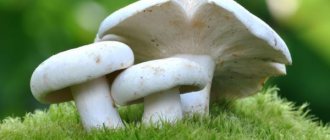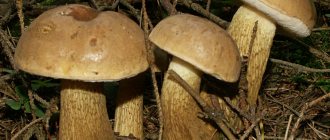Sometimes in common people or in everyday life you can hear a whole collection of names - bitter, bitter, hare mushroom, false white or false boletus - but this does not mean that friends talk about several completely different mushrooms, but on the contrary.
Its official name is gall mushroom (lat. tylopilus felleus), known for its belonging to the boletaceae family. It is mainly distributed in the regions of central Russia and is not popular among foresters due to its dubious reputation, because even if you have numerous processing recipes at hand, you cannot consume gall fungus.
How to distinguish gall mushroom
If the appearance of the bitter mushroom cannot be distinguished from others, then it should be cut lengthwise and tasted on the tongue.
If you feel a clearly incoming bitterness, then this is definitely a gall fungus.
Description
False porcini mushroom, also known as gall mushroom, also known as bitter mushroom, is a dangerous double of the real porcini mushroom. Inedible and poisonous!
False white mushroom.
hat
In youth, hemispherical, with age - hemispherical, later - prostrate. The skin is difficult to separate from the cap and has a color from light brown to creamy brown. The size reaches up to 10 cm in diameter.
Leg
Gall mushroom.
Cylindrical or club-shaped (with swelling at the base), light brown or light brown in color, with a characteristic mesh pattern on the surface, not much darker than the main color of the leg.
Spore-bearing layer
Tubular, dense, small, adherent tubes. The tubular layer of a young mushroom is painted white, turning pink with age.
When pressed, it acquires a distinct pink color. The spore powder of the gall fungus is pink, the spores are spindle-shaped, smooth.
Gorchak.
Pulp
The gall mushroom has dense, fleshy, white flesh. When cut or broken, it turns pink, oxidizing in air. The taste is distinctly hot.
Places where gall fungus spreads
Almost throughout Russia, Europe and America you can find gall fungus. Moreover, it grows in both coniferous and deciduous forests.
The period of rapid growth occurs at the beginning of summer. But the abundant appearance of adult mushrooms occurs in August-October, depending on the climate in a particular area.
Gorchak loves rotten and half-rotten stumps, the root system of trees protruding to the surface of the earth. Most often they grow in groups of 3-6 mushrooms. But less often they can be found in a single copy.
Edibility, benefits and harm
The gall fungus contains the alkaloid muscarine, which is present in fly agarics and its other poisonous relatives. But its dose is too small to cause serious harm to health and cause dangerous poisoning. False white is conditionally edible. In Vietnam, for example, it is considered a delicacy, but is not popular in our country. Although in the Volga region the custom of serving a mustard dish at funerals has been preserved, as a ritual one.
Bitterweed is not poisonous, but, as a rule, it is not eaten due to its bitter taste and the presence of toxic substances. Even one mushroom, soaked in water according to all the rules, evaporated and salted, can ruin an entire pot of soup. After heat treatment, the taste does not always improve. Bitterness can be masked with vinegar, a lot of spices, and long soaking. Some mushroom pickers take advantage of this and eat bittersweet. This must be done correctly, guided by the following recommendations:
- Only the caps of young mushrooms end up in the dish.
- They are pre-boiled (30-40 minutes) or soaked in water for 2 days, changing the liquid twice a day.
- After this, the product is used for salting or pickling. It is not advisable to cook soup or make roast from it.
In any case, a dish using bittersweet will not be healthy. A few days after consuming it, symptoms of poisoning may appear: weakness, dizziness, vomiting, pale skin. The greater the concentration of harmful substances, the more unpleasant consequences the intake of bittersweet will cause, including disruption of the liver and problems with bile secretion. Even without eating the mushroom, but simply tasting it on your tongue during collection, there is a risk of getting mild poisoning. Those who eat mustard regularly may develop cirrhosis of the liver.
The main danger of gall fungus is the toxins it contains. They accumulate in the pulp, enter the body and destroy the liver.
Mushroom research in Europe
Opinions about the dangers and benefits of gall fungus are divided. Research has been conducted in Europe on the biologically active compounds in false white. French scientists tested them for various properties beneficial to the body. The following medicinal features of bittersweet have been identified:
- antibacterial;
- choleretic;
- increasing immunity;
- antitumor and others.
In addition, European scientists have conducted experiments proving the influence of gall fungus components on the growth of cancer cells - it slows down. But this knowledge has not found wide distribution in the world.
Possibilities of bitter bitter poisoning
It is very difficult to get poisoned by mustard. This is due to the fact that the bitterness in it in its raw form is much lower than during heat treatment.
Once cooked, the mushroom becomes significantly more bitter, making it difficult to eat and not notice.
A person is simply not able to eat a large amount and obtain poisonous substances in a poisonous volume. Related to this is the fact that it is quite rare to meet a person who has been poisoned by gall fungus.
But if suddenly this happens, then the toxins from bittersweet begin to destroy the human liver.
Another insidious point is that toxins do not act immediately, but have a delayed effect. That is, they can begin to act in a week, or even in a month.
Poisonous or edible: different opinions
This variety can hardly be found in the atlas of poisonous lamellar mushrooms. This approach is due to the fact that it is almost impossible to eat bitter bitter: it has such a disgusting taste that the receptors in the mouth will not allow it to be chewed.
Let's consider why the false representative of the forest is dangerous, and whether it is poisonous:
- Western researchers claim: mustard contains toxic substances that are transmitted to humans even through the skin.
- Once inside, the components are quickly absorbed through the blood.
- Toxic substances settle in the liver cells and cause disruption of its functioning.
- A high concentration of dangerous components can provoke cirrhosis of the liver.
Despite this, some mushroom pickers are not worried about the inedibility of the gall fungus. Answering the question of what the gall mushroom is like, lovers of “quiet hunting” unanimously compare it with boletus mushrooms. And if bittergrass accidentally gets into the basket, they use it for pickling for the winter. Such methods should be abandoned: each person’s body is individual. While some people are able to digest bittersweet, others may experience poisoning.
Photo of gall fungus
Use in cooking
If the product is processed correctly, it can be eaten. However, do not exceed the dosage of 100 g per day. In China, these mushrooms are used in dry form - whole or ground. They are added to first and second courses to enhance the taste. To eliminate bitterness, the product is pre-soaked in water for 2–3 days. The liquid is changed every 3-4 hours to prevent molding.
In France, in order to eliminate bitterness, the product is first boiled in milk. It is then crushed and added to various dishes
You should not cook false boletus with other mushrooms. It is used only separately, after pre-treatment. It is also not worth boiling bitters in water right away, since it is very difficult to wash off the dark coating later. In addition, cooking in water without first soaking or boiling in milk only increases the bitterness.
Notes
- " bilious
and
bile
".
Bukchina B.Z., Sazonova I.K., Cheltsova L.K.
Spelling dictionary of the Russian language / reviewer: Academician of the Russian Academy of Sciences N. Yu. Shvedova. — 6th ed. - M.: AST-PRESS KNIGA, 2010. - P. 244. - 1296 p. — (Desktop dictionaries of the Russian language). — 3000 copies. — ISBN 978-5-462-00736-1. (by order of the Ministry of Education and Science of the Russian Federation No. 195 of June 8, 2009, the dictionary was included in the list of grammars, dictionaries and reference books containing the norms of the modern Russian literary language when used as the state language.) - [www.gramota.ru/slovari/dic/?word=%E6%B8%EB%F7%ED%FB%E9&all=x Word check on the GRAMOTA.RU portal]
- Lamaison JL, Polese JM.
The Great Encyclopedia of Mushrooms. - Cologne: Könemann, 2005. - P. 27. - ISBN 978-3-8331-1239-3. - Bauchet JM Experiences sur les proprietes curatives des champignons. Bull.trimester.Soc. mycol. France, 77, 4, 1961











